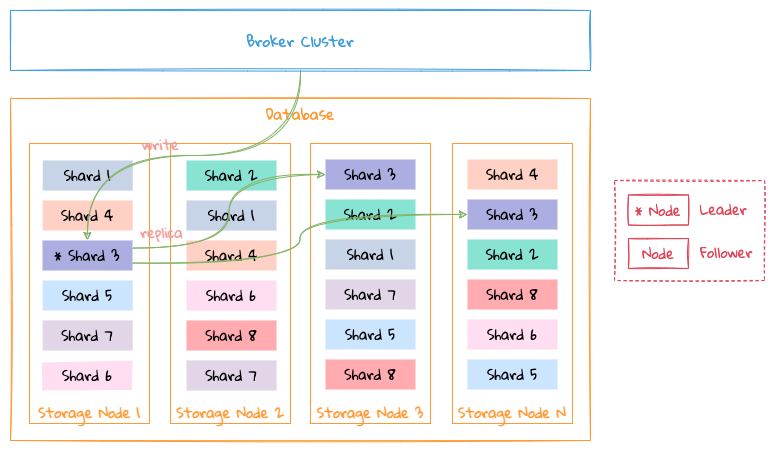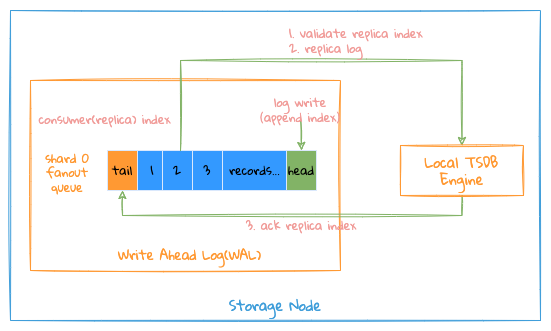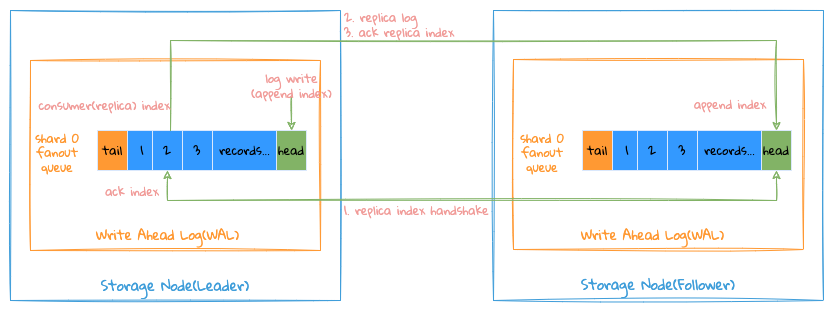Replication
Overview
For the replication of distributed storage, consensus protocols such as Paxos, Raft, and ZAB are commonly used in the industry. More than half of these protocols will sacrifice certain performance to strictly ensure data consistency.
The scenario faced by LinDB is that the amount of writing is huge, and the requirements for data consistency are not high. It also allows short-term data inconsistency and eventually consistent. Therefore, LinDB adopts the strategy that when successfully written to the Leader the write operation is successful.
Written to Leader is successful has the following benefits:
- Improving write performance;
- Any machine can be deployed in the cluster, while Paxos, Raft, ZAB, etc. require at least 3 machines;
Written to Leader is successful, has the following problems:
- Data consistency problem: once the Leader is down, a new Leader will be elected, then the new Leader copying new data may overwrite the data written by the old Leader;
- Data loss problem: once Leader is down, and the data block which was not copied to Follower is also damaged at this time, this part of data will be lost;
In order to solve the above problems and try to ensure that data is not lost, LinDB adopts a multichannel replication scheme, as shown in the following figure:
 Databae storage shard
Databae storage shard
Take the data shard Shard 3 as an example:
- When Node 1 is a Leader, 1-WAL write channel is enabled, Node 1 receives new data and writes it to the 1-WAL channel, and replicating the data into 1-WAL channel of Node 2 and Node 4;
- When Node 1 is down and Node 2 is elected as the new Leader, the 2-WAL write channel is enabled, and Node 2 receives new data and replicating the data into 2-WAL channel of Node 4;
- When Node 1 is up again, Node 1 continue to copy the data into 1-WAL channel that has not been copied to Node 2 and Node 4 to their corresponding 1-WAL channels . Node 2 will supplement the data in the 2-WAL channel to the 2-WAL channel of Node 1;
That is, data in write channel flows from Leader. For example, the 1-WAL channel is always the Node 1 replication channel to Node 2 and Node 4, and the 2-WAL channel is always Node 2 replication channels to Node 1 and Node 4, 4-WAL channel is always Node 4 replication channel to Node 1 and Node 2, and so on,
TIP
Node 1 corresponds to the unique identifier 1 in the cluster, and so on for other nodes.
This way of replication solves the following problems:
- Avoid data inconsistency: only one node is responsible for the authority of the data for each channel, so there will be no conflict;
- Avoid data loss as much as possible: as long as the data which has not been copied in the old Leader is still persistent at disk, it will be copied to other replicas after it gets up again. If the data that has not been copied in the old Leader is lost, then which will be lost forever;
Preconditions for multichannel replication:
- Out of order is allowed: data written to multiple channels loses its order. Transactions are not required for Time series data scenarios faced by LinDB so out of order is allowed.
TIP
Since a major feature of time series data is time correlation, LinDB also shards data by time according to this feature when storing data. Each time shard is a storage unit, so the actual replication channel is also stored with Units correspond one-to-one.
Local replication
 Local replication
Local replication
The entire Local Replication writing process is as follows:
- The system will start a writing goroutine for each Shard replication channel, this goroutine is responsible for all write operations on this channel, whatever it is a Leader or a Follower;
- First, data corresponding to namespace/metric name/tags/fields into the index file of the database will be written, and the corresponding metric id/time series id/field id will be generated, this operation is mainly about completing the conversion of string->int; Advantage of this conversion is that all data are stored in data types to reduce the overall storage size, because for each data point, metadata such as namespace/metric name/tags/fields is occupied by such as cpu{host= 1.1.1.1} load=1
1514214, In fact, after converting to id, the storage will be cpu => 1(metric id), host=1.1.1.1 => 1(time series id), load => 1(field id), simplified to 1 11514214=>1, please refer to inverted index for the specific index structure; - If writing index operation fails, it is considered that the writing has failed, and the failure is composed of two cases;
- Bad data writing format, such failures are directly marked as failures;
- Internal failure, the writing operations will be retried;
- When obtained ID, data will be written into storage uint, this process is similar to LSM, which writes data into the memory database firstly, and directly write to the memory to achieve high throughput performance. After the size of memory data reaches the memory limit, the Flush operation will be triggered. For details, please refer to Storage Format, Memory Database;
Here are two import replication Index for write operations:
- Consume(Replica) Index: where the writing goroutine has been processed, each write operation will first verify whether the Index is legal;
- Ack Index: which data in this channel has been successfully written and persisted to storage;
Here are a few things to note:
- The writing goroutine will consume the written data from the WAL channel in order, so the Replica Index is an ordered pointer, so it is easy to check with the persisted Index to verify the data whether it has been written;
- The Flush goroutine is used to synchronize the Ack Index to notify which data has been written successfully;
- Since all write operations write into memory firstly, and then persist the data into corresponding file. If the system crashes during this process, as there is no Ack Index, even if the data in the memory is lost, but when the goroutine starts again, it consumes the data in the WAL channel with Ack Index as the current Replica Index. This consuming process achieved that data can be recovered after crashing;
Remote replication
Pick Node 1 as Leader in the above figure with 3 Replications replicating data from 1-WAL as an example:
Node 1 acts a Leader of the shard to accept written data from Broker, Node 2 and Node 4 are both Follower accepting the replication request of Node 1, meanwhile the 1-WAL channel is used as data write channel.
 Remote replication
Remote replication
Index basic concept description:
- Append Index of each channel, indicating the writing position of the channel ;
- Each channel retains each Follower Consumer (Replica) Index and Ack Index, respectively indicating the position where each Follower is consumed (consumed but the request is still without successful consumption acknowledged) and position of successful consumption;
- Tail Index of each channel: indicates the minimum value of all Follower Ack Index, WAL before the Index is deletable ;
The entire replication process is as follows:
- Leader will start an independent goroutine for each Follower replication, get Follower Consumer(Replica) Index from WAL of Leader then send it to Follower;
- Follower compares the Append Index with Consumer(Replica) Index in local WAL;
- On equal: return Consumer Index to Leader as Ack Index (normal case);
- On not equal, return the Append Index in its own local WAL to Leader;
- After Leader receiving response, detect whether the Ack Index ofFollower is equal to Consumer(Replica) Index;
- On equal: update the Ack Index of the Follower (normal case);
- On not equal: here are some cases:
- On Follower Ack Index smaller than Tail Index of Leader WAL: this means that Follower local Append Index is too small while Leader has no data at that position, then Follower should reset its own Append Index as Tail Index of Leader;
- On Follower Ack Index is greater than the Append Index of the Leader WAL: this means that the Append Index of the Follower is too large, and the Leader has no data at this position, and the Leader WAL needs to be changed. Append Index** is raised to Follower Ack Index, and Follower Consumer(Replica) Index is raised to Follower Ack Index;
- On Follower is between Tail Index and Append Index of Leader WAL: Follower Consumer(Replica) Index will be reset to Follower Ack Index;
The process of Leader and Follower to initialize the replication channel is similar to TCP three-way handshake.
Sequentiality
Generally speaking, multichannel replication does not guarantee the order of the overall data. In most cases, only one of the channels is used. It is necessary to ensure the order of replication of the channel. With sequentiality, it is easier to know which data has been copied. Which data has not been replicated.
To ensure the sequentiality of replication process, it is necessary to ensure the order of the following steps:
- Leader send replication requests in order;
- Follower processes replication request in order;
- Leader responses to replication request in order;
Since the entire writing and replication process is based on the GRPC Stream long connection and single-goroutine processing mechanism, the above conditions can basically be guaranteed.

